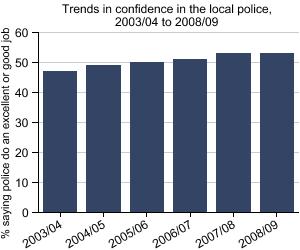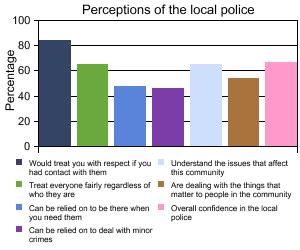The British Crime Survey (BCS) provides information on a wide range of public perception measures relating to crime and the criminal justice system. These include confidence in the police, victim and witness satisfaction with the police, and confidence in the police working with local agencies.
Overview
The British Crime Survey (BCS) asks respondents about their contacts with the police, their assessment of police performance and also asks questions about their views of the police. Victims of crimes the police came to know about are also asked about the service they received from the police.
In October 2004, the BCS included a new set of questions relating to people¡¯s perceptions of the local police. A greater emphasis on partnership working has resulted in the policing questions in the BCS being expanded to cover working in partnership. From October 2008,?a new set of questions was included in the BCS. These?relate to levels of confidence in the police working with local agencies to tackle the anti-social behaviour and crime issues that matter in the local area.
Technical Data
The British Crime Survey (BCS) is a nationally representative survey of approximately 47,000 adults living in private households in England and Wales. It is a face-to-face survey in which respondents are asked about their experiences of crime in the 12 months prior to their interview. They are also asked about their perceptions of crime and crime-related topics, such as their attitudes to the police.
The main BCS measure for confidence in the police is the percentage of respondents who believe the local police are doing ¡®a good or excellent¡¯ job. The BCS also includes questions about people¡¯s perceptions of the following seven aspects of their local police (how much they agree or disagree with the statements):
-
the police in this area can be relied on to be there when you need them
-
the police in this area would treat you with respect if you had contact with them for any reason
-
the police in this area treat everyone fairly regardless of who they are
-
the police in this area can be relied on to deal with minor crimes
-
the police in this area understand the issues that affect this community
-
the police in this area are dealing with the things that matter to people in this community
-
taking everything into account I have confidence in the police in this area
Since October 2007, the BCS has included two questions to measure public confidence in the police working with local agencies to understand and tackle the crime and anti-social behaviour issues of importance in their community. Respondents are asked how much they agree or disagree with the statements:
-
the police and local council seek people¡¯s views about the anti-social behaviour issues that matter in the area
-
the police and local council are dealing with the anti-social behaviour issues that matter in the area
Glossary
-
Calibration weighting
Calibration weighting is used on the British Crime Survey (BCS) and is designed to make adjustments for known differentials in response rates between different age by sex subgroups and households with different age and sex composition. For example, a household containing a 24-year-old male living alone may be less likely to respond to the survey than a household containing a 24-year-old male living with a young partner and a child. The procedure, therefore, gives different weights to different household types based on their age/sex composition in such a way that the weighted distribution of individuals in the responding households matches the known distribution in the population as a whole.
-
Confidence interval
Surveys produce statistics that are estimates of the real figure for the population under study. These estimates are always surrounded by a margin of error of plus or minus a given range. The confidence intervals for a particular statistic provide a range of values around that statistic where the ¡®true¡¯ (population) statistic is located with a given level of certainty. Confidence intervals can also be constructed for changes in estimates between years of the British Crime Survey (BCS) and for differences between population subgroups (see Statistical significance).
-
Sampling error
A sample, as used in the British Crime Survey (BCS), is a small-scale representation of the population from which it is drawn. As such, the sample may produce estimates that differ from the figures that would have been obtained if the whole population had been interviewed. The size of the error depends on the sample size, the size and variability of the estimate, and the design of the survey. It can be computed and used to construct confidence intervals. Sampling error is also taken into account in tests of statistical significance.
-
Statistical significance
Statistical significance is the probability that an observed difference or relationship in a sample occurred by chance, and that in the population no such difference or relationship exists. The British Crime Survey (BCS) estimates are subject to sampling error, so differences between estimates from successive years of the survey or between population subgroups may occur by chance. Tests of statistical significance are used to identify which differences are unlikely to have occurred by chance. In this publication, tests at the?5 per cent significance level have been applied (the level at which there is a?1 in 20 chance of an observed difference being solely due to chance).
-
Weighted data
Two types of weighting are used to ensure the representativeness of the British Crime Survey (BCS) sample. Firstly, the raw data are weighted to compensate for unequal probabilities of selection. These include: the individual's chance of participation being inversely proportional to the number of adults living in the household; the over-sampling of smaller police force areas; and the selection of multi-household addresses. Secondly, calibration weighting is used to adjust for differential non-response.
Contact Details
For statistical enquiries about this topic, please contact:
Crime Statistics
Email: crimestats.rds@homeoffice.gsi.gov.uk
Telephone: +44 (0) 20 7035 6823
Crime Statistics Home Office Statistics 5th Floor Peel 2 Marsham Street London SW1P 4DF


